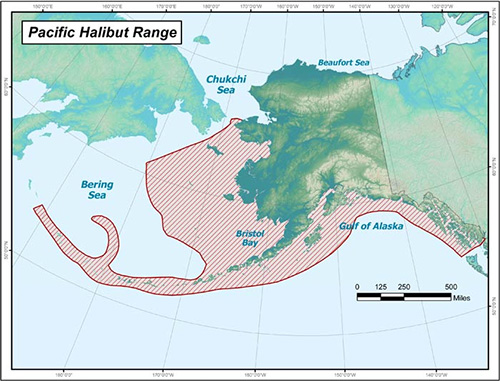|
Fish Factor Alaska halibut fishery could produce 20 million pounds if limit is reachedBy LAINE WELCH
November 04, 2016
The halibut fishery ends on Nov. 7 for nearly 2,000 longliners who hold IFQs (Individual Fishing Quotas) of halibut. The Alaska fishery will produce a catch of more than 20 million pounds if the limit is reached by the fleet. Last year, the halibut haul was worth nearly $110 million at the Alaska docks. For the first time in several decades the coastwide Pacific halibut harvest numbers increased this year by 2.3 percent to nearly 30 million pounds. Along with Alaska, the eight-month fishery includes the Pacific coast states and British Columbia.
Alaska Pacific Halibut Range
“Fishermen say they’re seeing some of the best fishing they’ve ever seen in their lives there, bigger fish, better production and you see that reflected in IFQ prices,” said Doug Bowen of Alaska Boats and Permits in Homer. The quota shares are sold in various categories, and the asking price for prime shares in Southeast waters has reached $70 per pound! IFQ asking prices for shares in the Central Gulf, the largest halibut fishing hole, also have increased to $60 a pound, according to several broker listings. But the buying there is not as aggressive as in the Panhandle. “They took a 5 percent cut – it’s the only area in the entire coast that didn’t stay the same or have an increase. There is still quite a bit of concern about the resource there,” he said. “And there’s still a lot of concern about other removals and possibly inaccurate accounting of bycatch.” Halibut shares in the Western Gulf sold for a record $48, Bowen said. Shares in regions of the Bering Sea were listed mostly in the mid-$20 range. The halibut fishery falls under the stewardship of the International Pacific Halibut Commission, which has set the annual coastwide catch limits based on surveys since 1923. Stakeholders will get a first glimpse of recommended catches at an upcoming IPHC meeting Nov. 29-30 in Seattle. Mum’s the word so far on any numbers for 2017. “They won’t reveal any information about how their surveys went, for better or worse, and I give them a lot of credit for that,” Bowen said, “because it would only fan the flames of speculation in the IFQ market.” On a related note: Linda Behnken of Sitka has received a presidential appointment as a Commissioner to the International Pacific Halibut Commission. Behnken has been a commercial fisherman for over 30 years, and since 1991 has been Executive Director of the Alaska Longline Fisherman’s Association. For 50 years, it’s been the most popular West Coast trade show for anyone who makes their living on the water. Pacific Marine Expo, dubbed Fish Expo, has bragging rights as one of the nation’s top trade shows, and it’s even bigger this year. “We are going to be 522 companies strong and 90 of them are brand new to the show. It just continues to grow,” said Denielle Christensen, Expo Director, adding that in this day of internet shopping, nothing replaces the “hands on” and networking of a real event. New to the show floor are 11 safety workshops, a Job Fair and a fishermen’s lounge. Seminars include selling your own catch, emergency crew duties, marine connectivity, salmon habitat and the importance of bait. The event also feature’s National Fisherman’s popular Fishermen of the Year competition and Highliner awards. Pacific Marine Expo takes place Nov, 17-19 at the Century Link Field in Seattle. Boats that catch cod with big pots are in the pre-implementation stage of making electronic monitoring a reality. That’s due to a steadfast push for three years by the Homer-based North Pacific Fisheries Association (NPFA) and Saltwater, Incorporated of Anchorage, a leader in data collection since 1988. The EM systems can replace or augment onboard observer coverage which can cost boat owners $400 a day or more. Armed with funding by the National Fish and Wildlife Foundation, the partnership proved that pot cod is a fishery that fits the bill because of the way the fish is brought on board. Starting in 2013, the pot codders set out to prove that using video cameras aimed at the catch could be cost effective and clearly show what’s coming aboard. “From 2013-2015 we had up to five boats and 13,000 pot hauls. Saltwater data reviewers were able to identify 99.6 percent of the more than 55,000 catch items to a species or a species group level. It was like, wow, this works. That really caught the managers’ attention,” said Nancy Munro, Saltwater founder and president. To get required weights of both catch and discards, the fishermen devised measuring grids on their sorting tables and Saltwater created a digital ruler that snaps nose to tail images of the fish, along with software that calibrates each to length and weight. On the basis of that work, federal managers gave the go-ahead for the pot cod fleet to begin EM pre-implementation starting January 1. Boats are needed to test out EM systems; all costs will be covered by the grant money. Questions? Contact Saltwater, Inc. or the NPFA. American Seafoods Company is again offering grants totaling $38,000 for community projects that address hunger relief, safety, housing, research, natural resources and cultural activities. The majority of awards range from $500 to $3,000 per organization. The deadline to submit applications is November 16. The awards will be announced by a community advisory board on December 1. Contact Kim Lynch at kim.lynch@americanseafoods.com or 206-256-2659.
Laine Welch ©2016 Laine can be reached
at msfish[AT]alaska.com
Representations of fact and opinions in comments posted below are solely those of the individual posters and do not represent the opinions of Sitnews.
SitNews ©2016 Stories In The News Ketchikan, Alaska
|
||

